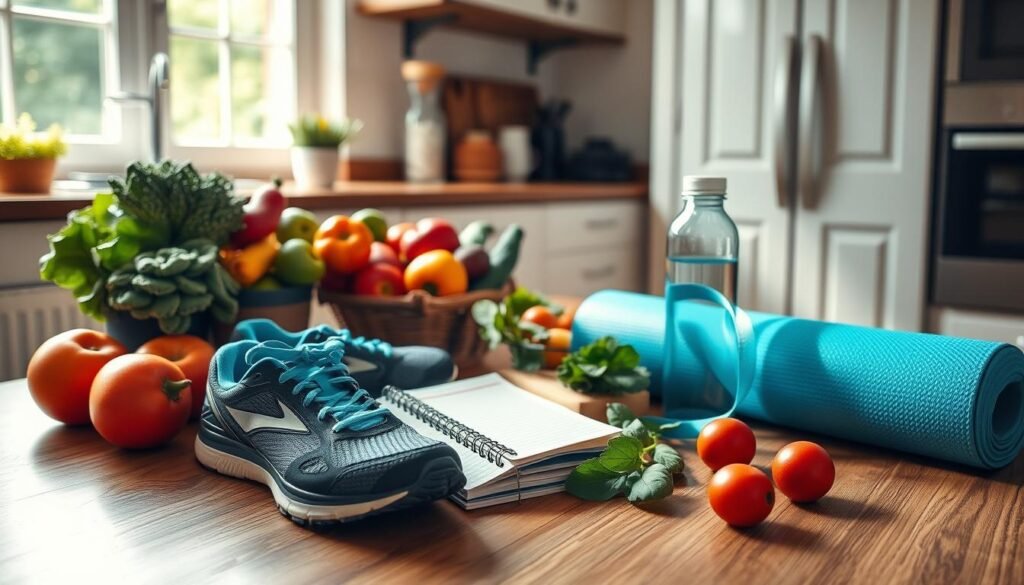

Starting a weight loss journey is more than just losing weight. It’s about adopting a lifestyle for lasting health. To succeed, you need to know about sustainable ways. Quick solutions might look good, but their results don’t last.
See weight loss as a complete journey. It should include a good diet, exercise, and changes in how you live. By doing this, you can avoid many diseases, feel happier, and live better.
Table of Contents
ToggleKey Takeaways
- Adopting weight loss requires a focus on sustainable strategies.
- A healthy lifestyle is key for long-term well-being.
- Weight management can reduce the risk of chronic diseases.
- Balanced diet and exercise are essential components.
- Weight loss is a journey, not just a destination.
- Lifestyle adjustments are crucial for success.
Understanding Weight Loss Basics
Learning the basics of weight loss is crucial for lasting success. It’s important to know about calorie deficit and metabolism. These concepts are key to effective weight management. We will look into these principles and their roles in losing weight.
What is a Calorie Deficit?
When you eat fewer calories than your body uses, you’re in a calorie deficit. This is important for losing weight because it makes your body burn stored fat. To figure out your calorie deficit, think about how many calories you need. This depends on your age, gender, and how active you are.
- To know how many calories you burn each day, calculate your Total Daily Energy Expenditure (TDEE).
- Trying to have a deficit of 500 to 1000 calories daily is good. This can help you lose 1-2 pounds a week safely.
The Role of Metabolism in Weight Loss
Metabolism is all about how your body turns food into energy. It’s vital for losing weight because it affects how fast you burn calories. Knowing about your metabolism can help you plan your weight loss better.
| Factor | Impact on Metabolism |
|---|---|
| Age | As you get older, your metabolism often slows down. |
| Gender | Men tend to burn calories faster than women. |
| Body Composition | Having more muscle means you burn more calories. |
Learning from real-life examples about foods that boost your metabolism can be helpful. Adding these foods to your diet, while keeping a calorie deficit, can help speed up your weight loss.
Creating Sustainable Diet Plans
Creating a successful diet plan is key for those aiming for healthy weight loss. It requires picking nutritious foods and planning your meals. We will look into how to select the right foods and offer diet plans that work.
Choosing the Right Foods
Adding healthy foods to your diet helps with sustained weight loss. It’s important to choose a variety of foods that are rich in nutrients but low in calories. Let’s consider some essential food groups:
- Vegetables: Options like spinach, kale, and broccoli give you fiber without many calories.
- Fruits: Berries, apples, and oranges offer important vitamins and satisfy sugar cravings.
- Whole grains: Foods such as brown rice, quinoa, and whole-grain bread provide lasting energy.
- Lean proteins: Chicken, fish, beans, and legumes keep muscle while you lose weight.
Shopping for whole, unprocessed foods improves meal quality. Planning your meals helps you make better choices and avoid unhealthy snacks.
Sample Diet Plans for Effective Weight Loss
Here are some sample diet plans. You can adjust them to fit what you like and keep weight loss going:
| Meal | Vegetarian Plan | Non-Vegetarian Plan |
|---|---|---|
| Breakfast | Oatmeal with berries and almonds | Scrambled eggs with spinach and whole-grain toast |
| Lunch | Quinoa salad with chickpeas and mixed greens | Grilled chicken salad with avocado and cherry tomatoes |
| Dinner | Stir-fried tofu with broccoli and brown rice | Salmon with sweet potatoes and green beans |
| Snacks | Sliced vegetables with hummus | Greek yogurt with honey and walnuts |
By following these suggestions and choosing a variety of foods, you can create a diet plan. This plan will not only help with weight loss but also boost your health.
Effective Exercise Routines for Weight Loss
Making exercise a regular part of your life is key to losing weight. Doing physical activities often helps melt fat away. It makes you healthier overall. There are many exercises to pick from whether you want to lose or keep your weight.
Types of Exercises That Burn Fat
Cardio is great for burning fat. Here are some top cardio exercises you can try:
- Running or jogging
- Cycling
- Swimming
- Rowing
- Dancing
High-Intensity Interval Training (HIIT) is also a top choice. It mixes really intense exercise bursts with brief rest periods. This method increases your heart rate big time. So, you end up burning a lot of fat even after the workout.
Incorporating Strength Training and Cardio
Strength training is super important as well. It makes your muscles bigger, which fires up your metabolism. This helps you lose more weight. Many studies show that mixing strength work with cardio is best. This way, you burn fat and build muscle at the same time.
When planning your workouts, consider this setup:
| Day | Exercise Type | Duration |
|---|---|---|
| Monday | HIIT | 30 minutes |
| Tuesday | Strength Training | 45 minutes |
| Wednesday | Cardio (Running) | 40 minutes |
| Thursday | Strength Training | 45 minutes |
| Friday | Cardio (Cycling) | 35 minutes |
| Saturday | Active Recovery (Yoga) | 30 minutes |
| Sunday | Rest Day | – |

Mixing cardio and strength training works wonders for weight loss. But, everyone’s body reacts differently to workouts. The key is finding the best plan that suits your own goals and fitness level.
Portion Control: A Key to Success
Understanding portion control is key to managing weight. It helps you know how much food is enough. This way, you can still enjoy your favorite meals and reach your health goals.
Understanding Serving Sizes
Serving sizes can confuse, leading us to eat more than needed. Knowing the correct serving sizes helps us choose better. Below, you’ll find serving sizes for different foods:
| Food Group | Standard Serving Size | Examples |
|---|---|---|
| Fruits | 1 medium-sized piece or 1 cup | 1 apple, 1 banana, or 1 cup of berries |
| Vegetables | 1 cup raw or ½ cup cooked | 1 cup of spinach, ½ cup of broccoli |
| Grains | 1 slice of bread or ½ cup cooked | 1 slice of whole-wheat bread, ½ cup of rice |
| Protein | 3 ounces | 3 ounces of chicken or fish |
| Dairy | 1 cup | 1 cup of milk or yogurt |
Practical Tips for Portion Control
To lose weight, easy portion control is crucial. Here are some tips:
- Use smaller plates to make your meals look bigger.
- Measure servings to know how much you’re eating.
- Listen to your body. Stop eating when you’re just satisfied.
- Put lots of veggies on your plate. They have fewer calories.
- Don’t keep junk food around. It’s easier to resist this way.
Healthy Eating Habits to Adopt
Adopting healthy eating habits is essential for good health and weight management. Mindful eating helps people tune in to their meals and choose better. It’s important to create balanced meals for necessary nutrients and overall health.
Mindful Eating Practices
Mindful eating means paying full attention while eating. It changes how we see our meals. Here are tips to start:
- Take smaller bites and chew thoroughly to savor each flavor.
- Limit distractions, such as phones or television, during meals.
- Pause between bites to assess hunger and fullness levels.
- Reflect on the sensations and emotions related to food choices.
Building a Balanced Plate
Including a mix of food groups in meals ensures nutrition. Aim to fill your plate with these parts:
| Food Group | Examples | Portion Size |
|---|---|---|
| Proteins | Chicken, fish, legumes | 1/4 of the plate |
| Carbohydrates | Brown rice, whole grains, vegetables | 1/4 of the plate |
| Fats | Avocado, nuts, olive oil | 1/8 of the plate |
| Vegetables | Leafy greens, colorful veggies | 1/2 of the plate |
Implementing Lifestyle Changes
Making lifestyle changes is key to long-term weight loss. We must focus on realistic goals and daily consistency. Having a healthy diet and exercising regularly are essential for success.
Setting Realistic Goals
It’s important to have achievable goals in weight loss. Setting clear and measurable goals helps keep track of progress. Aim to lose 1-2 pounds per week rather than attempting quick fixes. Breaking big goals into smaller ones keeps you motivated. It makes gradual progress feel rewarding.
The Importance of Consistency
Being consistent is crucial in weight loss. Regular exercise and eating right are important for lasting results. Staying true to your plan helps build momentum. Even when it’s tough, keeping committed means setbacks won’t stop you.

Boosting Your Metabolism Naturally
Boosting your metabolism can help you lose weight. Eating certain foods and sleeping well are key. They work together to improve your metabolic health.
Foods That Act as Metabolism Boosters
Eating the right foods can speed up your metabolism. Try to include these in your meals:
- Green tea: Contains catechins, which may enhance metabolic rate.
- Protein-rich foods: Items like chicken, fish, and legumes can increase the thermic effect of food (TEF).
- Spicy ingredients: Foods with chili peppers can temporarily elevate metabolism.
- Whole grains: Brown rice and oats require more energy for digestion, contributing to increased calorie burn.
- Healthy fats: Avocados and nuts support hormonal balance, aiding metabolism.
The Role of Sleep in Metabolism
Getting enough sleep is crucial for a healthy metabolism. Without it, you might gain weight. This happens due to hormonal imbalances that increase cortisol levels.
Quality sleep is also necessary for managing hunger. It helps control leptin and ghrelin levels. These hormones deal with hunger and fat storage. Aim for 7-9 hours of good sleep each night to boost your metabolism.
| Food Type | Metabolism Boosting Properties |
|---|---|
| Green Tea | Enhances fat oxidation and boosts metabolic rate. |
| Protein | Increases thermic effect, helping burn more calories during digestion. |
| Spicy Foods | Contain capsaicin, which may temporarily raise metabolism. |
| Whole Grains | Require more energy for digestion compared to refined grains. |
| Healthy Fats | Support hormonal functions related to metabolic health. |
Fat Burning Techniques That Work
People often look for quick and effective ways to burn fat. This section talks about high-intensity interval training (HIIT) and adding more movement into your day. These can help you burn more calories.
High-Intensity Interval Training (HIIT)
HIIT mixes short, intense exercise with periods of rest. This method gets your heart rate up fast, burning a lot of calories quickly. Even after you stop exercising, your body keeps burning calories. This is called the afterburn effect. HIIT has many benefits:
- Time-efficient workouts
- Improved cardiovascular fitness
- Increased metabolic rate
Incorporating Daily Activities To Burn More Calories
Making simple changes to your daily life can boost how many calories you burn. Adding extra movement into your day doesn’t have to take up workout time. You can try things like:
- Walk or bike to work instead of driving
- Take the stairs instead of the elevator
- Stand or walk during phone calls
These small changes can bigly impact your weight over time. Using these fat-burning methods can make everyday tasks help you get fitter.
Tracking Your Body Composition
Keeping an eye on body composition is key when losing weight. It lets you see the real changes in your body, beyond just the number on the scale. This understanding helps you set goals that are good for you.
It shifts your focus. You don’t just look at weight, but also at what that weight is made of. This approach leads to better health and satisfaction.
Understanding the Difference Between Weight and Body Fat
Just looking at weight isn’t enough to tell if you’re healthy. It changes with things like how much water you drink, what you eat, and if you’re building muscle. Body fat percentage tells you more accurately how much fat you carry.
This is important for those tracking their health progress. If your body fat goes down, it often means you’re getting healthier.
Tools for Measuring Progress
There are many tools out there for keeping an eye on body composition:
- Body Fat Scales: These scales guess your body fat using bioelectrical impedance.
- Skinfold Calipers: By measuring skin fold thickness at certain places, you can estimate body fat.
- Body Composition Analyzers: These give you details on fat, muscle, and water weight.
- Professional Assessments: Going to a fitness pro can get you exact numbers and advice.
| Tool | Advantages | Disadvantages |
|---|---|---|
| Body Fat Scale | Quick and easy to use | Can be inaccurate due to hydration levels |
| Skinfold Calipers | Cost-effective and portable | Requires practice for accurate measurements |
| Body Composition Analyzer | Provides detailed results | Can be expensive |
| Professional Assessment | Highly accurate and personalized | Usually requires an appointment and costs more |
Choosing the right tools helps a lot in weight loss journeys. It’s not just about losing weight but more about losing fat. This way, you get to a healthier state that improves your overall well-being.
Staying Motivated During Your Weight Loss Journey
Motivation is key on your weight loss path. Having strong support systems helps a lot. They give you encouragement and help you stay on track. Friends, family, or online groups can make you feel supported. This sense of belonging lifts you up when things get tough.
Finding Support Systems
Trusted friends or groups are crucial for keeping up your motivation. Connecting with others who share your goals is inspiring. Whether it’s a workout group, a class, or online forums, these connections make your journey shared.
Celebrating Small Wins
Celebrating every bit of progress is vital. A small reward or a new workout outfit for reaching goals works wonders. Such positive actions make the change stick, pushing you to stick with your goals.
| Completion Stage | Celebration Idea | Motivation Boost |
|---|---|---|
| First 5 lbs Lost | Spa Day | Increased Confidence |
| 10% Goal Reached | New Workout Gear | Feel Empowered |
| Consistent Exercise for a Month | Enjoy a Movie Night | Stay Committed |
Conclusion
Starting a weight loss journey means learning about healthy living. This article has talked about good diet plans, exercise, and the right amount of food. Each part is important for lasting success and feeling great.
Remember, every small choice helps you move forward. Choosing better foods or exercising more makes a big difference in health. Mindful eating and realistic goals make losing weight enjoyable and workable.
The real secret is being ready to act. Love the process, stay steady, and value the support of others. As you go on, remember it’s not just about a number on a scale. It’s about creating habits for a happy, sustainable life.
FAQ
What is the quickest way to lose weight?
Losing weight fast means eating less and moving more. Yet, losing weight and keeping it off needs time and lifestyle changes.
How important is portion control in weight loss?
Portion control is key in losing weight. It helps you keep track of how much you eat. This way, you can still enjoy your favorite meals but stay on track with your weight loss journey.
Can certain foods help boost metabolism?
Yes! Some foods like green tea and spicy dishes can help increase your metabolism. When you eat them and exercise, you burn more calories. This boosts your weight loss.
What dietary changes should I make for effective weight loss?
Eat more fruits, vegetables, whole grains, and proteins. Cut down on processed foods and sugary drinks. A healthy diet that fits your calorie needs is best.
How can exercise benefit my weight loss journey?
Regular exercise, including cardio and strength workouts, helps burn fat and boost your metabolism. It means more calorie burn and better body composition.
How can I stay motivated while losing weight?
Stay motivated by setting achievable goals and having a support network. Celebrate every win, no matter how small. Seeing progress keeps you going.
What is the difference between weight loss and fat loss?
Weight loss means dropping pounds, including water and muscle. Fat loss focuses on losing fat, not muscle. Monitoring body composition shows real progress.
Is it necessary to count calories for weight loss?
Counting calories helps some people create a calorie deficit. But not everyone needs it. Eating healthily and managing portion sizes works well too.
How does sleep impact weight loss?
Good sleep is crucial for weight loss. Lack of sleep can mess with hormones that control hunger and energy use. Quality sleep helps manage weight.
What are some effective daily habits to promote weight loss?
Simple habits like drinking water, choosing stairs over elevators, and walking help. These actions increase calories burned, aiding in fat loss.

As a trusted news source, Editorial Fox prides itself on upholding the highest standards of journalistic integrity. Our commitment to accuracy and fairness ensures that our readers can rely on us for reliable information.
Contact: editorial@rcopa.com
About Editorial Fox
At Editorial Fox, we are committed to delivering high-quality journalism that informs and engages our readers. Our team of experienced journalists and editors work tirelessly to bring you the latest news and analysis from around the world.
Copyright @2024 Editorialfox.com All Right Reserve.


Be the first to leave a comment